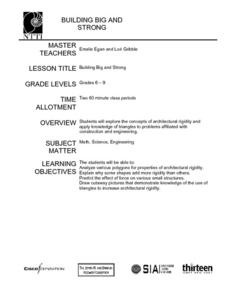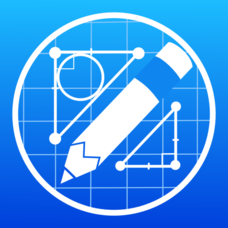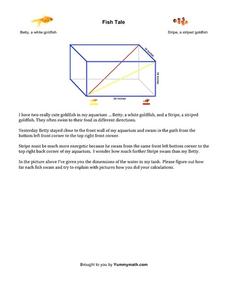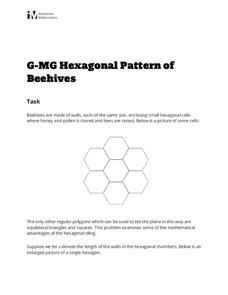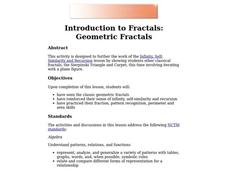Curated OER
Left-Middle-Right
In this shape recognition instructional activity, students respond to 3 questions that require them to record the name of the shapes located on the right, the left, and in the middle.
Curated OER
How to Classify Quadrilaterals
In this how to classify quadrilaterals activity, 3rd graders choose words to describe 3 quadrilaterals and to complete 3 sentences about the shapes.
Curated OER
Similar and Congruent
In this shapes worksheet, students decide if the given shapes are similar, congruent, or neither. Students complete 4 problems.
Curated OER
Woodlands Ribbonwork
Learners make art based on the ribbon work of the Woodland Indians. Background information on the art form and procedure are laid out in an easy to follow step-by-step format.
Curated OER
Faces, edges, and vertices
In this faces, edges, and vertices worksheet, students write how many faces, edges, and vertices each shape has. Students complete this for 2 plane shapes and 2 2D shapes.
Shodor Education Foundation
Visual Patterns in Tessellations
Geometers explore the concept of tessellations. They use a tessellation applet to manipulate shapes and design their own tessellation using the applet.
Sargent Art
Color Value Study
I love geometric art because it applies mathematical reasoning to an artistic endeavor. Creative kids use scale values to highlight their complex, repetitive, geometric designs. Symmetry, angles, and congruence are three concepts...
Curated OER
Building Big and Strong
Middle and high schoolers explore the concepts of architectural rigidity. They analyze a variety of polygons, and explain why some shapes add more strength to structures than others. The PBS video, "Building Big," is utilized in this plan.
Curated OER
Supplementary, Complementary, and Vertical Angles
By using circles that they cut out and label themselves, learners literally "get a grip" on the angles they identify: supplementary, complementary, and vertical. They solve missing measurements based on properties of supplementary,...
Bytes Arithmetic
Geometry Pad+
Graphing paper, pencil, ruler, protractor, and compass, all get replaced or supplemented with this dynamic geometry application. Here, you can create, move, and scale many different shapes, as well as, explore and change their properties...
Pennsylvania Department of Education
Build What I've Created
n this geometric lesson plan, students define and identify two dimensional shapes based on their attributes. They complete worksheets based on the geometric concepts.
Shmoop
Coordinate Proofs
How do you know you know? Prove it! The guide goes through several examples and includes a link to a video to teach learners how to work through coordinate proofs. The goal is to prove that different shapes are indeed that shape.
Teach Engineering
Let's Take a Spin: One-Axis Rotation
Investigate the effect of one-axis rotations on geometric figures. Scholars learn to use snap cubes and the right-hand rule to draw figures after rotations about the x-, y-, or z-axes. They try their hands at examples created by the...
Los Angeles County Office of Education
Assessment For The California Mathematics Standards Grade 4
Have scholars show what they know with a 20-page assessment aligned to the California State Standards. The test covers concepts such as large and whole numbers, all four mathematical operations, fractions, decimals, geometric figures,...
Utah Education Network (UEN)
Create, Classify, and Sort Quadrilaterals
Quadrilaterals can be quirky! Fourth graders use geoboards and bands to create four-sided figures. They analyze the attributes such as angle size and presence of parallel sides. As a result they learn to differentiate among...
Curated OER
Fish Tale
Here is a cute problem that requires visualizing two-dimensional shapes within a three-dimensional object, and using properties of triangles and the Pythagorean theorem to solve a real-world problem. There is a small mistake in this...
Illustrative Mathematics
Hexagonal Pattern of Beehives
Young geometers and biologists investigate the math of nature in an activity that is just the bee's knees. Participants will study the tessellations of hexagons in a beehive, along with the natural rationale behind the specific shape....
Curated OER
Area - Parallelograms and Trapezoids
In this finding the area of geometric shapes worksheet, students observe parallelograms and trapezoids and use the information given to find their areas. Students solve 4 problems.
Curated OER
Pattern Recognition
In this pattern recognition activity, students determine which shape comes next in nine strips of shapes and then draw that shape on the line provided.
Curated OER
Introduction to Fractals: Geometric Fractals
Students study and observe the patterns made by the areas of the Sierpinski Triangle. Students use the computer to draw two or three iterations to discover the number patterns. Students complete worksheets based on Geometric Fractals.
Curated OER
Sort and Graph
For this sorting and graphing worksheet, students sort 15 objects and then fill in bar graphs to tell how many of each shape there are. The shapes are: heart, star and triangle.
Curated OER
Identify the Shape
10 this geometry worksheet, learners identify the different angles created by polygons and name the shape created based on the number of sides. There is an answer key.
Illinois State Board of Education
Geoboard Areas
Middle school geometers determine the area of a shape on a geoboard or dot paper and draw figures that meet given area conditions. Working as a class, they develop and discuss various ways to draw geometric shapes with specified...
Curated OER
3-D Cubes
Young scholars investigate cubes. In this geometric solids instructional activity, students review geometric concepts previously taught, then logon to a computer game in which they find cube figures and identify the shadow of hidden cubes.
Other popular searches
- Geometric Shapes
- Geometric Shapes Worksheets
- 3 D Geometric Shapes
- Solid Geometric Shapes
- 3d Geometric Shapes
- Geometrical Shapes
- Solids Geometric Shapes
- Folding Geometric Shapes
- 3 D Geometric Shapes
- Area of Geometric Shapes
- Geometric Figures and Shapes
- Free 3 D Geometric Shapes









